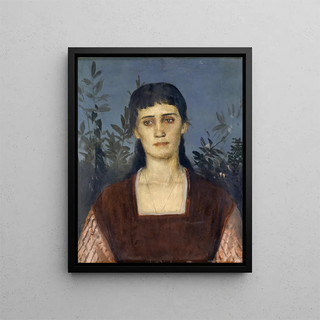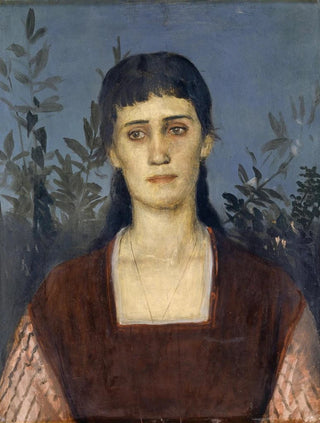Portrait of Clara Bruckmann-Böcklin, eldest daughter of the artist - Arnold Böcklin | Art print


View from behind

Frame (optional)
Reproduction Portrait of Clara Bruckmann-Böcklin, eldest daughter of the artist - Arnold Böcklin – Captivating introduction
The Portrait of Clara Bruckmann-Böcklin, the artist's eldest daughter, is an iconic work that embodies the very essence of 19th-century painting. This painting, created by Arnold Böcklin, does more than depict a human figure; it evokes a universe rich in emotion and symbolism. Through this portrait, the artist succeeds in capturing not only her appearance but also an atmosphere filled with tenderness and mystery. The presence of Clara, with her deep gaze and delicate expression, invites the viewer to immerse themselves in a world where reality and imagination intertwine, revealing an intimate facet of Böcklin's life.
Style and uniqueness of the work
Böcklin's style is distinguished by his bold use of color and light, which give his works an almost dreamlike dimension. In this portrait, warm tones and subtle nuances create a captivating visual harmony. The way the artist plays with shadows and highlights brings Clara's face to life, emphasizing her features while maintaining a certain softness. This stylistic choice reflects the influence of symbolism, an artistic movement that seeks to express ideas and emotions beyond mere representation. Thus, the portrait transcends the traditional framework of a family portrait to become a work of art in its own right, where every detail, from the background to the posture, contributes to the visual storytelling.
The artist and his influence
Arnold Böcklin, a major figure of symbolist painting, left his mark on his era with his unique approach to representation. Born in Switzerland in 1827, he developed a style that combines mythological elements with realism, creating compositions full of meaning. His work is not limited to the simple depiction of his contemporaries; it extends to universal themes, exploring human nature, death, and the mystery of existence. The portrait of his daughter Clara fits into this quest for understanding and expression. As a father, Böcklin not only painted his child but also immortalized

Matte finish

View from behind

Frame (optional)
Reproduction Portrait of Clara Bruckmann-Böcklin, eldest daughter of the artist - Arnold Böcklin – Captivating introduction
The Portrait of Clara Bruckmann-Böcklin, the artist's eldest daughter, is an iconic work that embodies the very essence of 19th-century painting. This painting, created by Arnold Böcklin, does more than depict a human figure; it evokes a universe rich in emotion and symbolism. Through this portrait, the artist succeeds in capturing not only her appearance but also an atmosphere filled with tenderness and mystery. The presence of Clara, with her deep gaze and delicate expression, invites the viewer to immerse themselves in a world where reality and imagination intertwine, revealing an intimate facet of Böcklin's life.
Style and uniqueness of the work
Böcklin's style is distinguished by his bold use of color and light, which give his works an almost dreamlike dimension. In this portrait, warm tones and subtle nuances create a captivating visual harmony. The way the artist plays with shadows and highlights brings Clara's face to life, emphasizing her features while maintaining a certain softness. This stylistic choice reflects the influence of symbolism, an artistic movement that seeks to express ideas and emotions beyond mere representation. Thus, the portrait transcends the traditional framework of a family portrait to become a work of art in its own right, where every detail, from the background to the posture, contributes to the visual storytelling.
The artist and his influence
Arnold Böcklin, a major figure of symbolist painting, left his mark on his era with his unique approach to representation. Born in Switzerland in 1827, he developed a style that combines mythological elements with realism, creating compositions full of meaning. His work is not limited to the simple depiction of his contemporaries; it extends to universal themes, exploring human nature, death, and the mystery of existence. The portrait of his daughter Clara fits into this quest for understanding and expression. As a father, Böcklin not only painted his child but also immortalized
12,34 €






